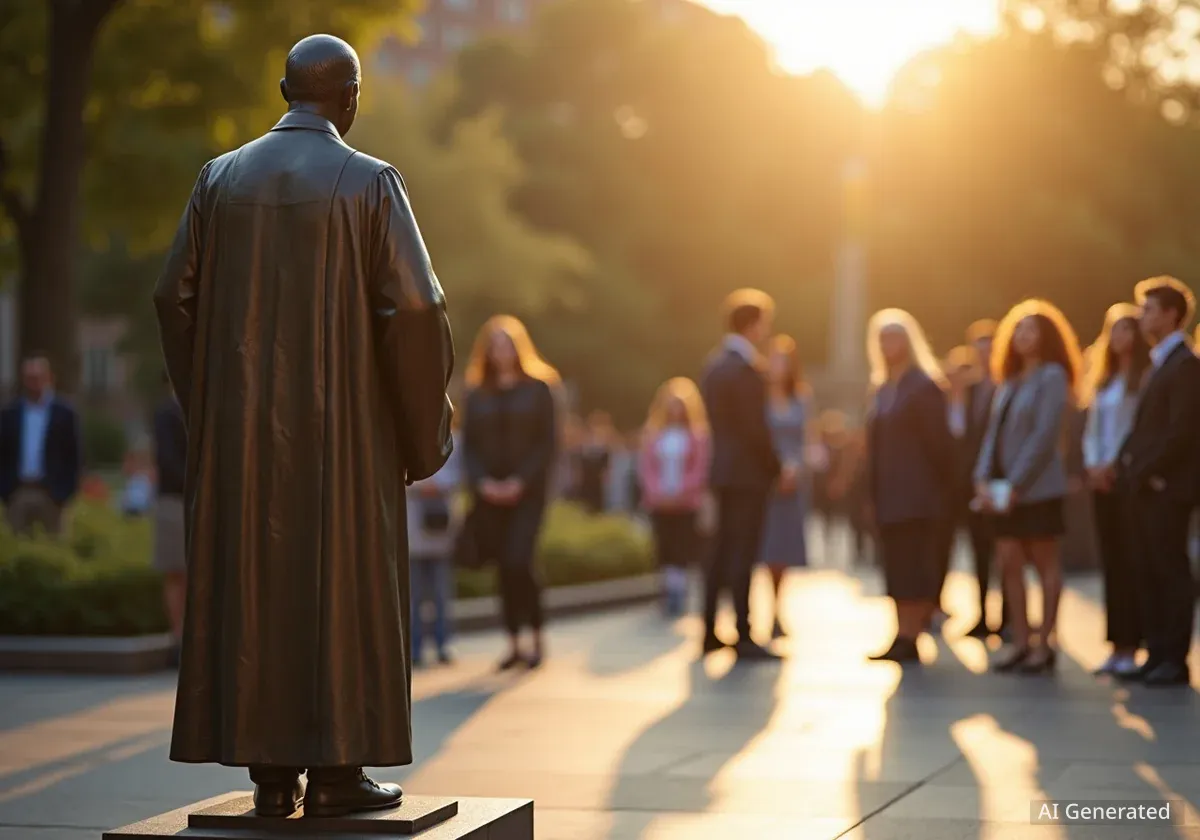Florida A&M University (FAMU) has permanently honored the legacy of its eighth president, Dr. Frederick S. Humphries, with the unveiling of a new statue on its Tallahassee campus. The ceremony, held on Friday, October 17, 2025, celebrated Dr. Humphries' transformative 16-year tenure, which is widely credited with elevating the university to national prominence.
The bronze statue was revealed in front of Lee Hall, the university's main administrative building, during the annual Homecoming weekend. The event drew a crowd of alumni, faculty, and students, all gathered to pay tribute to a leader who reshaped the institution's future.
Key Takeaways
- Florida A&M University unveiled a bronze statue of its former president, Dr. Frederick S. Humphries, on October 17, 2025.
- Dr. Humphries served as FAMU's president for 16 years, from 1985 to 2001.
- The statue is located in front of Lee Hall and was unveiled during the university's Homecoming celebrations.
- His presidency is noted for significant growth in enrollment, research funding, and national academic recognition for FAMU.
- Family members described the statue as a symbol of his "enduring spirit" and unwavering commitment to the university.
A Lasting Tribute to a Visionary Leader
The decision to erect a statue in Dr. Humphries' honor reflects his profound impact on Florida A&M University. During his leadership from 1985 to 2001, the university experienced a period of unprecedented growth and academic achievement. University officials have stated that the monument serves as a permanent reminder of his vision and dedication.
Positioned prominently in front of Lee Hall, the statue ensures that Dr. Humphries' presence will be felt by future generations of students and faculty. The unveiling ceremony was a central event of the 2025 Homecoming weekend, a time when the university community, past and present, comes together to celebrate its heritage and achievements.
Symbolism and Location
The choice of Lee Hall as the site for the statue is significant. As the administrative heart of the university, it is a place where key decisions about the institution's direction are made. Placing the monument here connects Dr. Humphries' legacy directly to the ongoing governance and progress of FAMU.
During the ceremony, his son, Frederick Humphries Jr., spoke about the deeper meaning behind the bronze figure.
"His commitment to FAMU was unwavering; it was constant. This statue is more than a bronze and stone statue; it’s a symbol of his enduring spirit. And I think that is what really is important and what I want to leave you with. It’s about the spirit."
This sentiment was shared by many alumni in attendance, who view Dr. Humphries as the architect of the modern FAMU they know today.
Who Was Dr. Frederick S. Humphries?
Dr. Frederick S. Humphries (1935-2021) was a distinguished chemist and academic administrator. Before his presidency at FAMU, he served as the president of Tennessee State University. His leadership was characterized by a focus on academic excellence, strategic recruitment, and institutional growth. After leaving FAMU in 2001, he went on to serve as president and CEO of the National Association for Equal Opportunity in Higher Education (NAFEO).
The Humphries Era: A Period of Transformation
Dr. Humphries' 16-year presidency is often referred to as a golden era for Florida A&M University. His strategic initiatives led to remarkable and measurable successes that fundamentally changed the institution's trajectory.
One of his most celebrated achievements was his aggressive recruitment of top-tier students. He famously targeted National Achievement Scholars, who are among the highest-scoring African American students on the PSAT/NMSQT. His efforts were incredibly successful, making FAMU the number one institution for attracting these scholars for much of the 1990s.
By the Numbers: The Humphries Impact
- Enrollment Growth: During his tenure, student enrollment at FAMU more than doubled, growing from under 5,500 to over 12,000 students.
- National Recognition: In 1997, TIME Magazine and The Princeton Review selected FAMU as the "College of the Year."
- Research Funding: The university's research funding increased dramatically, rising from approximately $8 million to over $50 million annually.
Elevating Academic and Research Profile
Beyond student recruitment, Dr. Humphries was committed to building FAMU's reputation as a serious research institution. He oversaw a significant expansion of graduate programs, including the establishment of new doctoral degrees in fields like pharmacy and engineering.
This focus on advanced degrees and research helped attract highly qualified faculty and substantial federal and state funding. The university's endowment also grew significantly under his financial stewardship, providing a more stable foundation for future growth. According to university records, this period saw the establishment of numerous research centers and institutes that continue to operate today.
Community and Legacy
The unveiling ceremony was not just a university event but a community celebration. Local leaders and alumni from across the country traveled to Tallahassee for the occasion, highlighting the widespread respect and admiration for Dr. Humphries.
The statue project was reportedly supported by a combination of university funds and contributions from alumni and donors who wished to see his legacy formally recognized on campus. The process, from conception to unveiling, was a collaborative effort involving the university administration, the FAMU National Alumni Association, and the Humphries family.
An Inspiration for the Future
Current FAMU President Larry Robinson, Ph.D., spoke at the event, noting that the statue will serve as an inspiration. He remarked that Dr. Humphries set a standard for excellence and ambition that continues to guide the university. The monument, he explained, is not just about looking back but about motivating current and future students to strive for greatness.
As Homecoming festivities continued throughout the weekend, the new statue quickly became a popular landmark. Students and alumni were seen gathering around the monument, taking photographs and reflecting on the history of their university. It stands as a testament to a leader whose work ensured that Florida A&M University would not only survive but thrive on the national stage.





